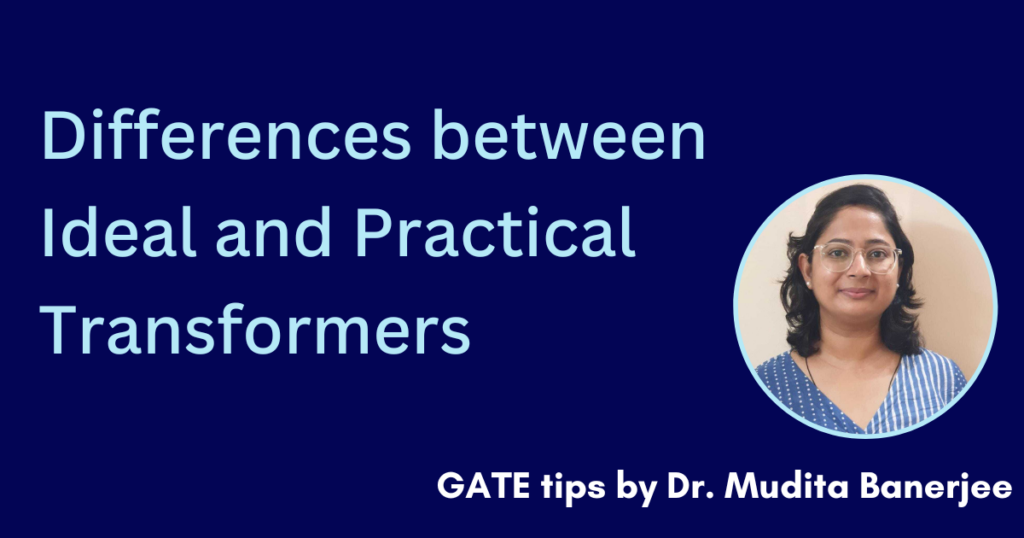In electrical engineering, study of transformer is very important. Transformers allow electricity to be usable by changing voltage levels according to applications.
Transformers are fundamental devices used in electrical power systems to transfer energy between circuits at different voltage levels. While ideal transformers are often used as a theoretical concept, practical transformers are the ones we encounter in real-world applications.
In this article, you will learn about the ideal and practical transformers in detail.
What is transformer ?
Transformer is a static device used to transform electrical energy from one source to another without any change in frequency.
The transformer works on the principle of Faraday’s law of electromagnetic induction.
In the transformer, there are two coils- primary coil and secondary coil on the transformer core. The core laminations are joined in the form of strips. The two coil have high mutual inductance. When an alternating current passes through the primary coil, it creates the varying magnetic flux.
According to the Faraday’s law of electromagnetic induction, this change in flux induces an emf (electromotive force) in the secondary coil, which is linked to the core having a primary coil.
What is use of transformer?
We know that, in ac power system, there is generation, transmission and distribution at different voltage levels. This process of generation, transmission and distribution is done through the stationary/static device called as transformer.
Types of Transformer
There are two types of transformer :-
i) Ideal transformer
ii) Practical transformer
Let us start with Ideal transformer.
Ideal Transformer
An ideal transformer is a transformer which has zero energy losses i.e. it does not have core loss or hysteresis loss. It has 100% efficiency and it has 0% voltage regulation. In this transformer, the output power is equivalent to the input power. There is no power loss within the transformer.
In real life, ideal transformer does not exist .Transformer contains some type of losses.
Let us understand this with the help of diagram, consider the transformer below, There are two types of winding primary winding and secondary winding.

■ When the primary winding is given supply, both the windings have negligible winding resistance. The resistance in primary winding is R1=0 and in secondary winding also resistance is R2 = 0 . There is zero winding resistance.
Therefore , As we know that the Cu loss = I2R = 0
■ In ideal transformer, there is no leakage flux. The flux in the core is confined within the core only. There is no flux which is completing its path through air.
■ There is negligible core losses in ideal transformer. The iron loss taking place in the core is zero.
Iron loss = Hysteresis loss + Eddy current loss
Therefore, in case of ideal transformer, the hysteresis and eddy current loss is zero.
The next difference is that , the ideal transformer has infinite permeability of the core. i.e. μ=∞. The flux is created by the magnitizing current . So there is no need of magnetizing current in the core as there is infinite permeability.
Practical Transformer
Practical transformer is a transformer which we see in real -time. It has following characteristics:-
i) It does not have zero energy losses.
ii)Efficiency is less than 100%.
iii) The voltage regulation is more than 0% .
The winding resistance is present in practical transformer. Let us understand this with the help of diagram below.

■ In practical transformer there is two winding, primary winding and secondary winding. Winding resistance is present. As there is presence of resistance and reactance both in the practical transformer. The primary winding and secondary winding contains the Cu losses . (Due to this Cu loss the efficiency of transformer decreases.
■ The leakage flux is also present in the practical transformer. But in practical transformer, the total flux is not confined till the core only. As
Core loss = Hysteresis loss + Eddy current loss
In practical transformer, core loss is also present.
■ In practical transformer, there is finite permeability of the core.
Let us summarize the differences between ideal transformer and practical transformer in short.
| Sr. No. | Ideal Transformer | Practical Transformer |
| 1. | There is negligible winding resistance. | Winding resistance is present . |
| 2. | There is no leakage flux for ideal transformer. | Leakage flux is also present. |
| 3. | There is no core losses for ideal transformer. | Core losses is present. |
| 4. | In ideal transformer, efficiency = 100% and voltage regulation = 0%. | In Practical transformer, the efficiency is less than 100% and voltage regulation is greater than 0. |
| 5. | There is infinite permeability of the core. | There is finite permeability of the core. |
| 6. | There is no energy loss. | There is energy loss. |
In this way, we can differentiate the Ideal and Practical transformer.
Hope, so. You have clearly understood the concept of Ideal and Practical transformer.
Best Course for Electrical Machines
By Dr. Mudita Banerjee


